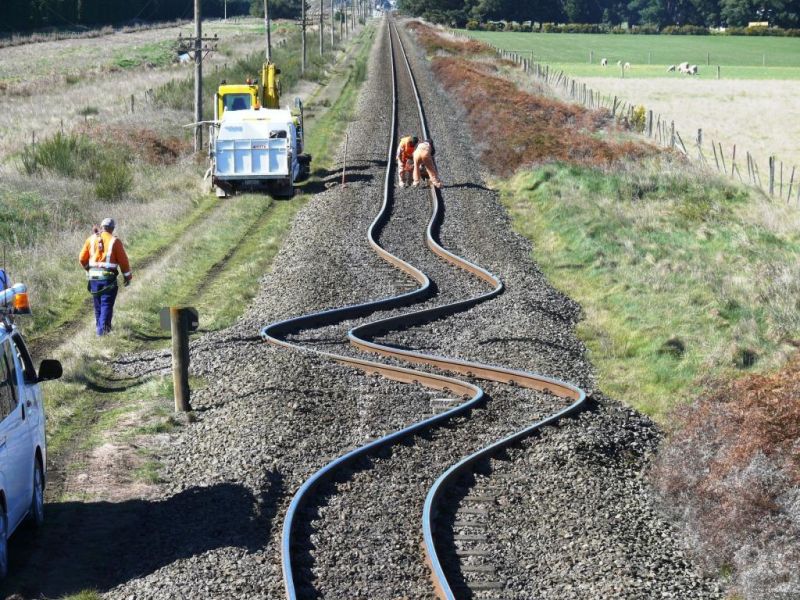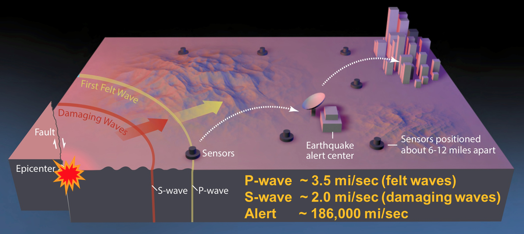Development of Earthquake Early Warning Systems
/Typical track deformation due to ground surface motion in an earthquake.
Synopsis of the GSOC Friday night lecture given on September 21, 2018, with speaker William Burgel, retired employee and consultant of Union Pacific Railroad.
by Carol Hasenberg
Recently joined GSOC member William Burgel, retired from working for and consulting with the Union Pacific Railroad, spoke to GSOC in September 2018 about his experiences in preparing the railroad system for earthquakes. His expertise stretches back to the 1960’s, and along with performing his job for the railroad company, helped organize and deploy early warning systems for earthquake shaking applicable to government and industrial participants.
After graduating from the University of Michigan in the 1960’s, Burgel went to work for the Union Pacific Railroad in Pocatello, Idaho. In 1968, the Borah Peak earthquake made him concerned for the safety of railroad bridges, and this led him to develop an early warning system for shaking on the Union Pacific system.
His first warning system was to request that the National Earthquake Information Center (NEIC) in Golden, Colorado, telephone a warning to the railroad whenever larger events occurred. Then this system was replaced in 1983 with a fax system that worked rather well from 1983-1991. Magnitude 5 and over (M5.0+) earthquakes were targeted in this system. Stations at 2 mile increments called “blocks” signaled whether they received an electrical signal that passed through the rails or not. Problems were that track separation in cold weather changed the block’s response to positive, but track offset due to earthquakes didn’t affect the signal, since the track segments would still be touching.
Burgel arrived in Portland in 1986 when the dispatch center for UPRR moved there. He liked living in Portland and in 1989, when the UPRR moved the dispatch center to Omaha, Nebraska, far from earthquake country, Burgel opted to stay in Portland and work as a consultant for the company.
An important event driving the development of more sophisticated systems occurred on June 28, 1992, when the Landers earthquake occurred in the southern California desert. It was the strongest California earthquake in 40 years and it derailed a train from track offsets. As a result UPRR held meetings with the USGS researchers in Menlo Park, California, and researchers at 33 universities to discuss a new system. All the academics were excited that someone was really going to use their system. UPRR also invested a sizable amount in research donations to promote the development of the system.
As the algorithms for the new railroad warning system were developed, the USGS expressed concerns about false alerts coming up with a bogus earthquake and/or missing an event. But UPRR convinced the techs that they preferred erring on the side of caution. The Spring Break Quake, or the Scotts Mills Earthquake in Oregon, 1993, gave a successful test of the new system.
So the plan that was developed in early 1990s was to build a system of broad band seismographs to monitor earthquakes all over the country, which was released by the USGS as Early Notification System (ENS). UPRR was quite pleased with this system and wanted to make sure the research continued, so they continued funding grants of $100,000 per year, spread out to ten universities, including a couple in the St. Louis area (the nearby New Madrid fault produced a series of very earthquakes in 1811-1812). This system is still in use today.
ShakeAlert Earthquake Early Warning System for the United States West Coast (www.shakealert.org)
The current early warning system in development, ShakeAlert, has evolved from a Japanese system, Shinkansen, which worked directly from sensors on the track to the train. ShakeAlert sends a signal from a sensor to an earthquake alert center. The center can broadcast the warning to multiple clients. At UPRR a trip wire alerts the trains. The system is designed to beat the S waves to the sites of potential damage. There is a gap of time between the propagation of the initial P (pressure) waves and the S (shear) waves, which cause most of the damage. There is generally a bit of time to figure out the epicenter and territory affected by the quake and stop the trains in that area. This system has had limited operation in California since 2012 and has been used in several earthquake events.
Seismic Station build-out progress as of December 2018 (www.shakealert.org)
Oregon will be in the PNW section of the ShakeAlert system, being built in a phased approach. Burgel’s wish list is for Oregon to get this system operational. The funding is not all there and $2M is still needed for the network sensors. If the reader is like minded, he suggests you contact your legislators. One problem Burgel foresees on the Oregon coast is that the sensors are there on the coast and not out in the ocean. So, there would not be much warning, in the event of a Cascadia Subduction Zone quake, for coastal clients. There would be about a minute of warning in Portland. Although if the propagation of rupture is from south to north along the Cascadia Subduction Zone Fault, then Portland may have up to 3 minutes of warning prior to damaging shaking.
You the reader can also be a part of the USGS ENS early warning system. What to do if you get a warning? Avoid injury! Stay in wood frame houses, don’t get in an elevator, get out of and away from unreinforced masonry buildings (they can throw bricks quite a distance from the parapets), don’t stand under power poles. Other resources for seismic preparedness include the Cascadia Playbook Overview produced by the state office of Emergency Management. Also available online is The Oregon Resilience Plan put out by OSSPAC. It might be a good idea to check out some of these resources and prepare, because basically you’ll be on your own for quite awhile in the event of a major earthquake.




























































Field Trip Director
Annual Newsletter Editor
fieldtrips@gsoc.org